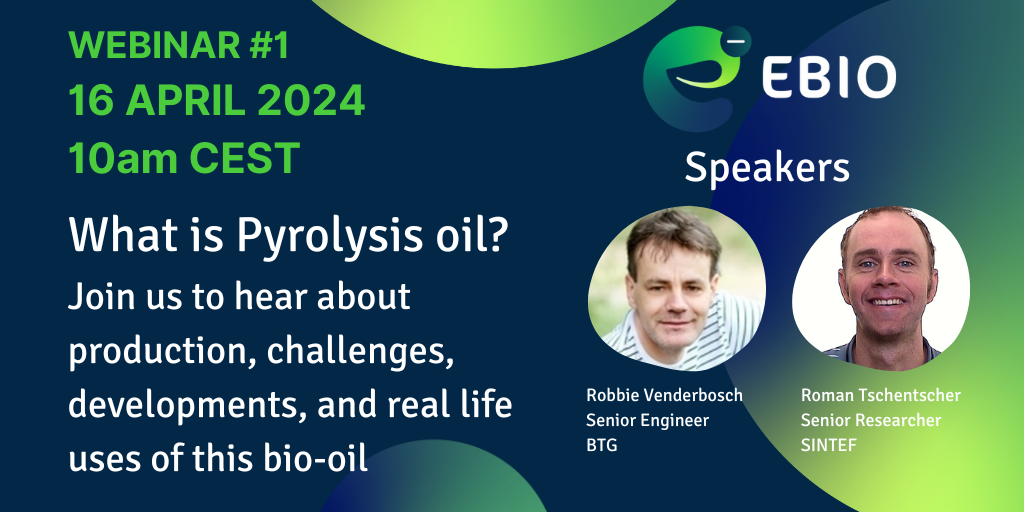If you missed the first episode of the EBIO webinar series, or you would like to watch it again, the full recording is available here: https://youtu.be/8LD2oq-a2ZE?si=YuiCLMXf2Uf-lT2M
The webinar welcomed 130 guests online and received about 20 questions.
A recap of all the questions asked can be found in the table below:
| Question | Answer |
| Thank you the presenter, can we use the pyrolysis oil directly without optimization? | For combustion pruposes, yes. It will be more difficult in others. |
| more espicially for mechanical applications?, thank you | There are some efforts to evaluate the lignitic oil fraction as additive for lubricants. There the molecular size has to fit, requiring some additional fractionation. The aqueous sugar phase is too instable and reactive. |
| Hello Robbie, just wondering how much the composition of your products changes depending on the biomass source used? | It really depends on the ash / contaminant content. The more of these, the higher the water content, the more phase separation, the lower the oil yield. |
| In naming Pyrolysis oil vs pyrolysis liquid? please explain | The correct term is pyrolysis liquid, as it consists of an aqueous phase (containing carabohydrate derivates)and an oil phase(lignin-based). |
| thank you for the presentation, but i’m producing my pyrolysis oil but i’m getting 2 phases, more of liginitic phase really, i changed the condensation process but with no luck. i was wondring why this phase separation is pronoced (my yield is only 10% viscous liquid) and from a technicall point of view can i name this a pyrolysis liquid ?? | You use probably a slow pyrolysis process, which produces larger portions of lignitic compounds. The way is to increase the heating/cooling rate and minimise the high temperature residence time to just a few seconds. This also increases the yields of sugars and acids, which act as emulsion stabilisers. |
| What a beatiful and instiful presentation.please what is the thermal capacity of biomass for pyrolysis oil taking Plate-Tank-Conflict into consideration. | We focus on lignocellulosis residues (wood pellet residues, straw, saw dust, thinnings) to minimise the effects on food production. |
| Has the different fractions of the hydrogented oil tested in automobiles and what is the success rate? | For automotive, best is to get rid of all oxygen. This delivers a mix of fuels (in boiing range light; gasoline; kerosene; diesel) |
| How long is fast pyrolysis oil stable at room temperature vs stabilised pyrolysis oil? | could be years, depending on how it was produced (óne-phase or not). Stabiloised oil are better, also because we can evaporate part of the water (so no phase separation occurs). |
| Robbie, do you have any project or plan to tackle the isolation or purification of aromatic chemicals such as guaiacol or the DCM-solubles? | We do some work in New Wave. Besides, in a recently finalised project ABC-Salt we produced aromatics and others from lignin (also technical lignin/Lignoboost). There will be a defence thesis next week April 23 in Groningen on this topic, showing a very high carbon yield (>80%) going from lignin to liquid fuels. Ref: https://www.rug.nl/research/enteg/agenda/phd-defence-balaji-sridharan-catalytic-conversion-of-lignocellulosic-biomass-to-biofuels-and-bi?lang=en |
| Do you know how efficient is the complex treated pyrolysis process in comparison to HTL process? | I have studied HTL in quite some details, and the overall carbon yields can be very high: typically 80-85% from biomass to the crude: however, the crude is not a liquid per se, it seems more like solid like structure that may be a bit fluid at higher temperatures. Its upgrading may be a bit easier than for pyrolysis oils. However, the process is much more complex than pyrolysis. For me, pressurising solid bio-materials (wood, straw, …) typically is a no-Go, with some exceptions. Let’s say, some challenges need to be resolved. |
| i am actually using Fast pyrolyisis process with batch system and staged condensation | We tried to avoid: you will get two products, which are rather close to each other in main components (apart from water), so we do not see a clear benefit |
| Have you ever try to apply biochar produced during pyrolysis to crack the tar composition to improve the quality of biooil quality? If so, what is efficiency of the system? Biochar as a catalyst rather than the commercial catalyst ? | no. We do not have a system where we can separate the char from the process. We use the char to be combusted and deliver the heat back into the sand. Btw, the char produced is very hygroscopic; if separated it should be handled with great care, which makes it a very expensive exercise to extract it, handle it, store it or likewise. |
| How does this process compare to just storing electricity in battery? How mayy kWh of electricity do you need to produce 1 kg of biofuel? | we hope we can add 2e + 2H per molecules.. For sugars this is around 1200 C/g (also noted in our tests) |
| How does this process compare to just storing electricity in battery? How mayy kWh of electricity do you need to produce 1 kg of biofuel? | we hope we can add 2e + 2H per molecules.. For sugars this is around 1200 C/g (also noted in our tests) |
| How much does the change in biomass compostion and properties have an affect on oil yields and oil properties | see above (ash/contaminants) |
| Great presentstion, thanks! Have you consider to upgrade the sugar phase via hydrothermal route? Seems reasonable since you have ca. 30 wt. of sugar and rest is water. Thank you in advance for answer and greetings from UGent and Prof. Ronsse reseach group! | yes. We called in High Presusre Thermal Treatment. There is a PhD thesis on this (Twente University) from Dragan Knezevic |
| In comparison to HVO, could you briefly describe whether there is competitiveness or a technological outlook? | In principal there is more biomass than HVO. We try to mimic HVO processing by adding stabilised oils (or the deoxgenated version), I do not want competition.. There doesn’t have to be |
| i’m producing my pyrolysis oil but i’m getting 2 phases, more of liginitic phase really i am actually using Fast pyrolyisis process with batch system and staged condensation i am trying to optimise my yields and wondring about the importance of fractionation and does it distilation effect the nataure of the pyrolysis oil? | Distillation of the ater makes the product more like a one-phase. (but visocisty may be a problem). More info in the answers above. |
| are you pre-treating the biomass with acids to remove ash before pyrolysis? | we did.. But it is an expensive options… (not only acids itself, but processing, drying, acid generation…) |

